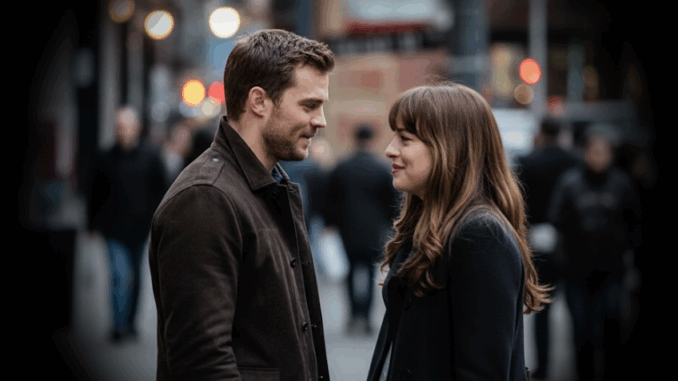
For years, fans of the Fifty Shades franchise have speculated about what really went on behind the closed doors of movie sets that seemed more like pressure cookers than playgrounds. Jamie Dornan and Dakota Johnson were thrown together in a project that demanded chemistry so intense it blurred the lines between performance and reality. Now, nearly a decade later, whispers about what may have truly unfolded behind the camera refuse to fade away. Were they just colleagues bound by a contract, or was there a forbidden connection that insiders tried desperately to keep under wraps? The answer depends on who you ask, but one thing is certain: “They didn’t want this story out.” Those words, allegedly spoken by someone close to the production, have sent fans spiraling into speculation.
From the beginning, both Dornan and Johnson projected a mix of professionalism and playful banter in interviews. Yet their eyes often betrayed them, flashing signals that fans dissected frame by frame. Every behind-the-scenes clip became fuel for an online community of truth-seekers, convinced that the actors were not just embodying Christian Grey and Anastasia Steele, but slipping into something far more personal. Hollywood thrives on mystery, and for Dornan and Johnson, the dance between denial and unspoken intimacy became part of the saga itself. Tabloids latched onto every casual touch, every inside joke, every red-carpet glance. Publicists dismissed it all as “good acting,” but skeptics wondered how much of that heat could truly be manufactured. Was the forbidden connection real, or simply the greatest PR strategy of the decade?
Adding weight to the rumors were the accounts of anonymous crew members, some of whom hinted at tensions on set that went far beyond standard movie-making stress. One claimed that entire days were reshot because the chemistry between Dornan and Johnson was “too raw, too unscripted.” Another suggested that certain candid moments had to be cut from the final films because they looked “too real to pass off as acting.” Whether exaggerations or half-truths, these whispers formed a storm that neither actor could fully escape. The producers, eager to protect the billion-dollar franchise, allegedly imposed strict rules: no off-camera intimacy, no public displays that could fuel gossip, no late-night rendezvous caught by lurking paparazzi. But rules, as history has shown, are often made to be broken. And for two stars locked in a world of heightened desire and constant scrutiny, the forbidden connection became irresistible to imagine—even if no one will confirm it outright.
Both Dornan and Johnson have offered carefully measured words when pressed on their dynamic. Johnson once admitted in an interview, “We were there for each other in ways people can’t understand,” a statement vague enough to maintain innocence but provocative enough to spark endless interpretations. Dornan, on the other hand, has tried to emphasize the strain of playing such roles, saying, “It’s not comfortable, it’s work.” Yet even in his denials, fans heard a tone of defensiveness, a man determined to shut down curiosity before it burned his carefully constructed life outside the franchise. After all, Dornan’s marriage and family life have been placed under a magnifying glass for years, with tabloids eager to frame Johnson as the invisible third figure in the background of his domestic stability. Did he ever slip? Or is the forbidden connection more about what fans projected than what actually occurred?
The psychology of forbidden attraction plays heavily into this saga. To millions, Dornan and Johnson were avatars of longing, forbidden love, and dangerous intimacy. The public became addicted to the possibility that fiction had spilled into reality. Every denial from the actors felt like fuel for more speculation: “Of course they’d deny it—what else could they say?” The rumor that won’t die has become less about uncovering an actual affair and more about maintaining a myth, a fantasy that prolongs the allure of Fifty Shades far beyond its final installment. In some ways, the forbidden connection is more powerful as a rumor than it ever would be as a fact. The truth might be mundane, but the whispers carry the weight of endless possibility.
Still, there are moments that seem impossible to dismiss. Johnson, reflecting on the filming years later, once said, “We were in it together, and nobody else will ever know what that means.” Such cryptic reflections only deepen the mystery. Fans point to lingering handshakes at press junkets, unguarded smiles during bloopers, and the sense that their bond never quite ended with the final take. If there truly was nothing more than friendship, why does the speculation continue to thrive a decade later? Why does the Hollywood machine seem so determined to redirect the conversation every time it surfaces? Perhaps because, as one insider allegedly put it, “They didn’t want this story out.”
The forbidden connection between Jamie Dornan and Dakota Johnson remains one of Hollywood’s most intoxicating enigmas. It straddles the line between truth and fantasy, between marketing and reality. Whether or not they crossed a line off-camera, their bond clearly left an imprint not just on their lives, but on the collective imagination of millions. The franchise may be over, but the myth endures—an eternal reminder that sometimes the most compelling stories are the ones no one is supposed to tell.
